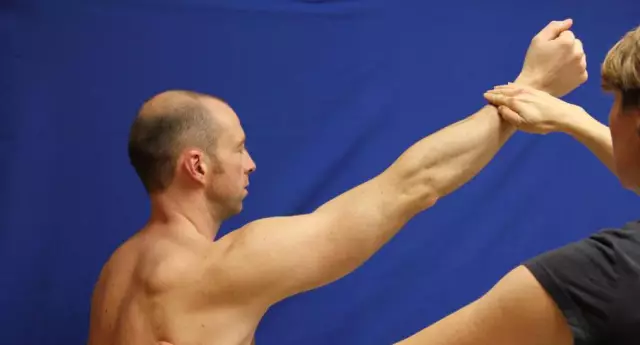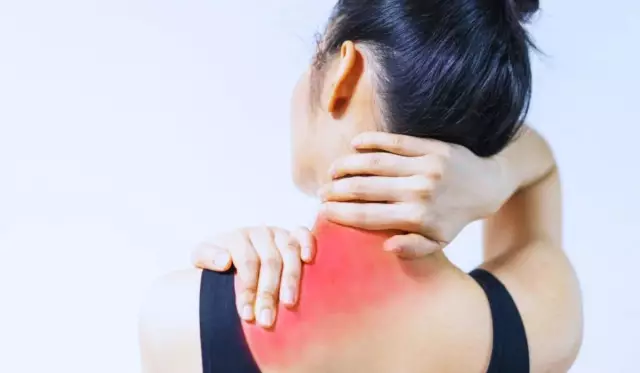- Author Rachel Wainwright [email protected].
- Public 2023-12-15 07:39.
- Last modified 2025-11-02 20:14.
Amyotrophy
Brief description of the disease

Muscle atrophy refers to the process that leads to a decrease in the volume and degeneration of muscle tissue. Simply put, the muscle fibers begin to thin out, and in some cases even disappear altogether, which leads to a serious limitation of motor activity and prolonged immobility of the patient.
In medical practice, several types of atrophy are distinguished, but we will talk about them a little below, but for now we will dwell in more detail on the reasons for the appearance of this pathology. Atrophy of the muscles of the legs and other limbs of the body occurs due to:
- decrease in metabolism and aging of the body;
- chronic diseases of the endocrine glands, intestines, stomach, connective tissue;
- infectious and parasitic diseases;
- disorders of the nervous regulation of muscle tone associated with poisoning, polyneuritis and other factors;
- congenital or acquired enzyme deficiency.
Muscle atrophy - symptoms and clinical picture
The primary form of the disease is expressed in direct lesions of the muscle itself. This pathology can be caused by both poor heredity and a number of external factors - injuries, bruises, physical overstrain. The patient quickly gets tired, the muscle tone is constantly falling, sometimes involuntary twitching of the limbs is noted, which indicates damage to motor neurons.
Secondary muscle atrophy - treatment is based on eliminating the underlying disease and other reasons that led to the onset of the atrophic process. Most often, secondary muscle atrophy develops after injuries and infections. In patients, the motor cells of the feet, legs, hands and forearms are affected, which leads to a limitation of the activity of these organs, partial or complete paralysis. In most cases, the disease is characterized by a sluggish process, but exacerbations are also possible, accompanied by severe pain.
The secondary form of the disease is divided into several types:
- neural myotrophy - in this case, muscle atrophy is associated with deformation of the feet and legs. In patients, gait is disturbed, it acquires the character of a steppage, when a person raises his knees high when walking. Over time, the reflexes of the feet completely fade away, and the disease spreads to other limbs;
- progressive muscle atrophy - symptoms appear, as a rule, in childhood. The disease is difficult, accompanied by severe hypotension, loss of tendon reflexes and twitching of the limbs;
- Aran-Duchenne muscle atrophy - mainly localized in the upper extremities. In patients, interosseous muscles and fingers atrophy. The hand takes the shape of a "monkey's brush". In this case, the sensitivity of the limbs is preserved, but the tendon reflexes completely disappear. The atrophy process progresses steadily and over time affects the muscles of the neck and trunk.
The main symptom of all types of atrophy is a decrease in the volume of the damaged muscle. This is especially noticeable when compared with the paired organ of the healthy side. Also, muscle atrophy, the symptoms of which depend on the severity of the process, always leads to a decrease in muscle tone and is accompanied by painful sensations on palpation of the limbs.
Muscle atrophy - treatment of the disease

The choice of treatment method depends on many factors, including the form of the disease, the severity of the process and the patient's age. Drug treatment involves taking such medications as: disodium salt of adenosine triphosphoric acid (30 injections intramuscularly), vitamins B1, B12 and E, galantamine (10-15 injections subcutaneously) and proserin (orally or in the form of subcutaneous injections).
Also of great importance are: choosing the right diet, physiotherapy, massage, therapeutic exercises, electrotherapy, psychotherapy and spiritual practices. If muscle atrophy leads to a child lagging behind in terms of intellectual development, then neuropsychological sessions are prescribed to him, designed to smooth out the problems in communication and learning new things.
It is worth noting that at this point in time, doctors do not have a medicine that can guaranteedly cure atrophy of the muscles of the legs and other extremities. Nevertheless, a correctly chosen technique can significantly slow down the atrophy process, increase the regeneration of muscle fibers, and return lost opportunities to a person. To do this, it is necessary to carefully adhere to the doctor's recommendations, carry out all prescribed medical procedures and, most importantly, do not lose heart, because you can live in harmony with the world with any, even the most serious illness.
YouTube video related to the article:
The information is generalized and provided for informational purposes only. At the first sign of illness, see your doctor. Self-medication is hazardous to health!






